9/25/2013
Growing Kiwis
Chris Beytes
This summer,
GrowerTalks traveled about as far away from our home base of Chicagoland as we’ve ever been: New Zealand. Your scribe was invited down by grower Andrew Tayler, second-generation co-owner of Rainbow Park Nursery and Rainbow Trees in the colorfully named town of Ramarama, near Auckland. The country’s association, Nursery & Garden Industry New Zealand, has its annual meeting in late June, and Andrew, a fan of our e-newsletter Acres Online, thought I might make an interesting speaker. The result was a weeklong exploration of the horticulture industry of this unique country, best known to outsiders for bungy jumping and “Lord of the Rings.” Here’s a pictorial and some observations of the Kiwi industry:
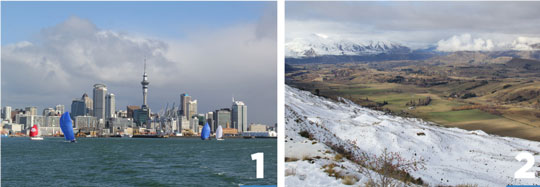
1 | New Zealand is as stunning as everyone says, although not all of it is exotic and mountainous. New Zealand is two islands, with Auckland near the north end of the north island, where it’s almost subtropical. Landscape-wise, the Auckland area is more like rural England, with rolling hills and pastures separated by hedgerows. But climate-wise, think of a slightly cooler San Diego. That’s because Auckland is at almost the same latitude south as San Diego is north. Late June is the dead of winter, yet it was only showery and cool. Metro Auckland is home to 1.5 million of the country’s 4.4 million residents. Sparsely populated, there’s just one major north-south artery, aptly named State Highway 1.
2 | Of the south island, I only visited the city of Queenstown in the Central Otaga agricultural region, which is bordered to the north by the jagged peaks of the Southern Alps. This is adventure sport territory, along with wine and other agriculture. And yet, despite the fact that the next stop south is Antarctica, the climate at the country’s southernmost city, Invercargill (population 53,000), is similar to that of the British Isles.
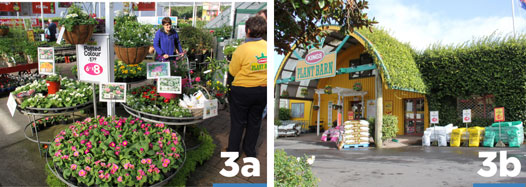
3a, b | Considering that it was the middle of winter during my visit, the garden centers were well-stocked with typical early spring annuals and shrubs: cyclamen (both indoor and landscape), cineraria, pansies, primula, roses, camellias, hellebores, fruit trees. Citrus is popular, as is other dooryard fruit, including feijoa (guava) and blueberries. Winter veggies are abundant, too (veggie gardening may be even hotter here than back home). This is a King’s Plant Barn near Auckland.
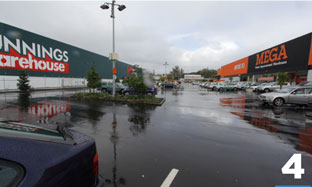
4 | Chains seem prevalent, while stand-alone independents are less common, at least around Auckland. Mitre 10 and Bunnings are the Lowe’s and Home Depot (or is it Home Depot and Lowe’s?) of New Zealand, and each have plans to open more stores in coming years, for which growers are gearing up. A third chain, The Warehouse, is more like Walmart. Palmers is a formerly independent chain that was owned for a while by the big box chain Mitre 10. Mitre 10 sold it; the new owners, Palmers Franchise Systems, have in turn sold the individual stores to new owners. They have 15 stores. King’s Plant Barn is an eight-store independent. Nichol’s, which I did not visit, has three stores on the south island.
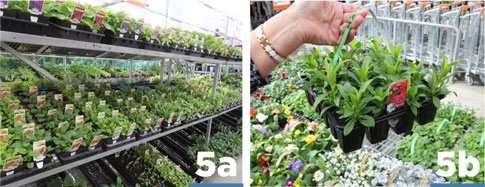
5a, b | Featuring mainly packs and small pots, plant packaging is not dissimilar to what we’re used to except in name. Like I reported from Australia back in 2011, packs are called “punnets or “cell packs.” “Potted colour” is the term for 10-cm. (roughly 4-in.) annuals. I saw some interesting sizes, including 24-cell packs ($11.97 at Mitre 10). Trees and shrubs often go into plastic or woven bags rather than pots.

6 | Quality in every outlet I visited was good to excellent. Variety, both inside and out, was also excellent, especially considering the time of year. Gardeners here are fortunate. If I noted anything negative, it’s that all the centers are so equal in selection, quality and display that there’s little to distinguish them. One retailer told me it’s because it’s a small country and there are relatively few growers, and they all tend to sell the same products to everyone. Only the country’s two biggest growers, Zealandia Horticulture and T&M Nurseries, are mostly exclusive to just one chain (Mitre 10 and Bunnings, respectively).
Prices are pretty healthy, best as I could tell. The U.S. and NZ dollars aren’t far off one another (at least after paying the exchange fee at the airport), and consumer prices felt high to me. They were certainly healthy in the garden centers, with six-packs going for $6.77. But 10-cm. (4-in.) potted color is low-balled by almost everyone, with “six for $8” signs quite common.

7a, b | Zealandia was the only pure bedding plant grower I visited, and as mentioned earlier, they’re one of the big two. Operations manager Jamie Curry showed me around their Panama Road facility near Auckland. He was cagey about revealing total production numbers, but said they do about 40,000 packs and 24,000 10-cm. potted colours per week during peak sales times, along with half a million strawberry plants a year. They’re well automated, including flat fillers and conveyor systems, including large buffer belts feeding forklift trucks that can transport 240 packs at a time.
Speaking of packs, we saw the largest trays we’ve ever seen here: 72 cm. (28.3 in.) long. They hold 10 6-packs each, and were designed to fit three-wide in their trucks. Note the safety vests the ladies are wearing. That’s government safety regulation. Behind the camera I had one on, too.

8a | Rainbow Park, my host for the week, is investing $2 million to construct 61,000 sq. ft. of Venlo glass greenhouse equipped with Dutch trays, 19-ft. gutters and a big packing house, all in an effort to keep up with anticipated demand from their big box and grocery customers. Avid travelers, Andrew Tayler and his father, Peter, “aim to grow the quality we see in Europe,” Andrew states.
8b | Rainbow grows a wide range of potted plants, including phalaenopsis, miniature roses, anthuriums and other foliage, bromeliads, herbs and veggies, and “perennials”—the region’s term for anything in color that’s not a native or an indoor potted plant. They even wholesale pottery. Next to the greenhouse operation is sister company Rainbow Trees, which grows what the name implies. Why so diverse? To spread sales and risk across as wide a business as possible—important in a small market, Andrew explained.

9a, b | Annton Nursery, about an hour and a half south of Rainbow, is managed by Steve Burton. Formerly a 100% natives nursery (started as a hobby his mom, Ann), Steve has expanded the business into color, fruits, veggies and other “exotics,” which now make up 65% of sales. But natives are still important; Annton has its own selections of hebes (under their Hollywood Hebes brand) as well as phormium. Blueberries are a growing crop, as are large (2.5 liter) in-fruit veggie plants and even combo six packs of lettuce (he sold 26,000 such packs to Mitre 10 for $5.50 wholesale).
9c | Steve Burton is one of the more thoughtful and philosophical growers I met in New Zealand. Says Steve, “We’re now starting to deal with consumers, not gardeners,” who are “driven by impulse, not knowledge.” He also says that today’s consumers shop “when they feel like gardening, not when they should be gardening.”
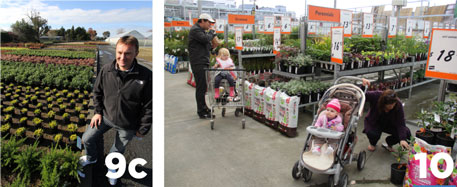
10 | New Zealand is a nation of people who love the outdoors and take every opportunity to enjoy it (although I suspect they leave the bungy jumping to the tourists). Which bodes well for the industry down there. With an ancestry of primarily English and Scottish, the gardening culture is strong. One grower told me when I asked him how he got into the business, “My parents are mad gardeners.” I’d say they’re a generation or two closer to the gardening/farming culture than we are in the states. And the Gen-X growers I met said their friends seem keen on gardening, especially vegetables.
GT